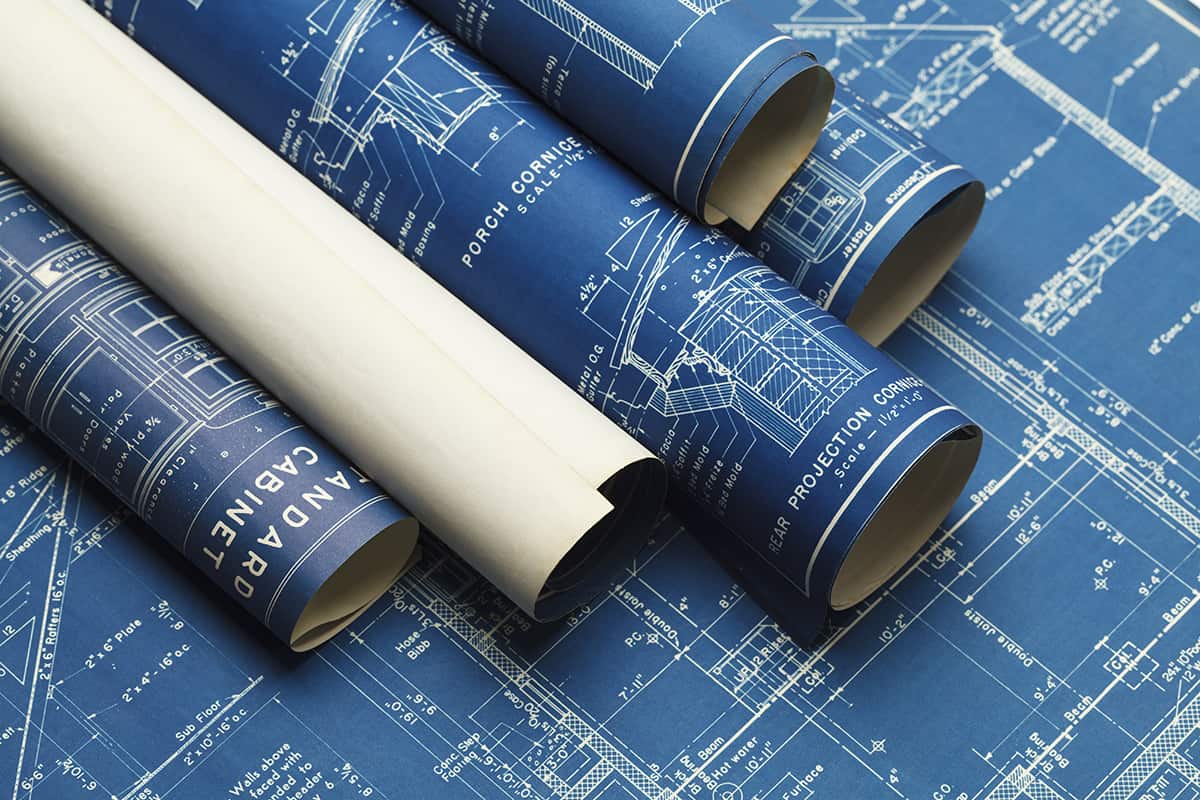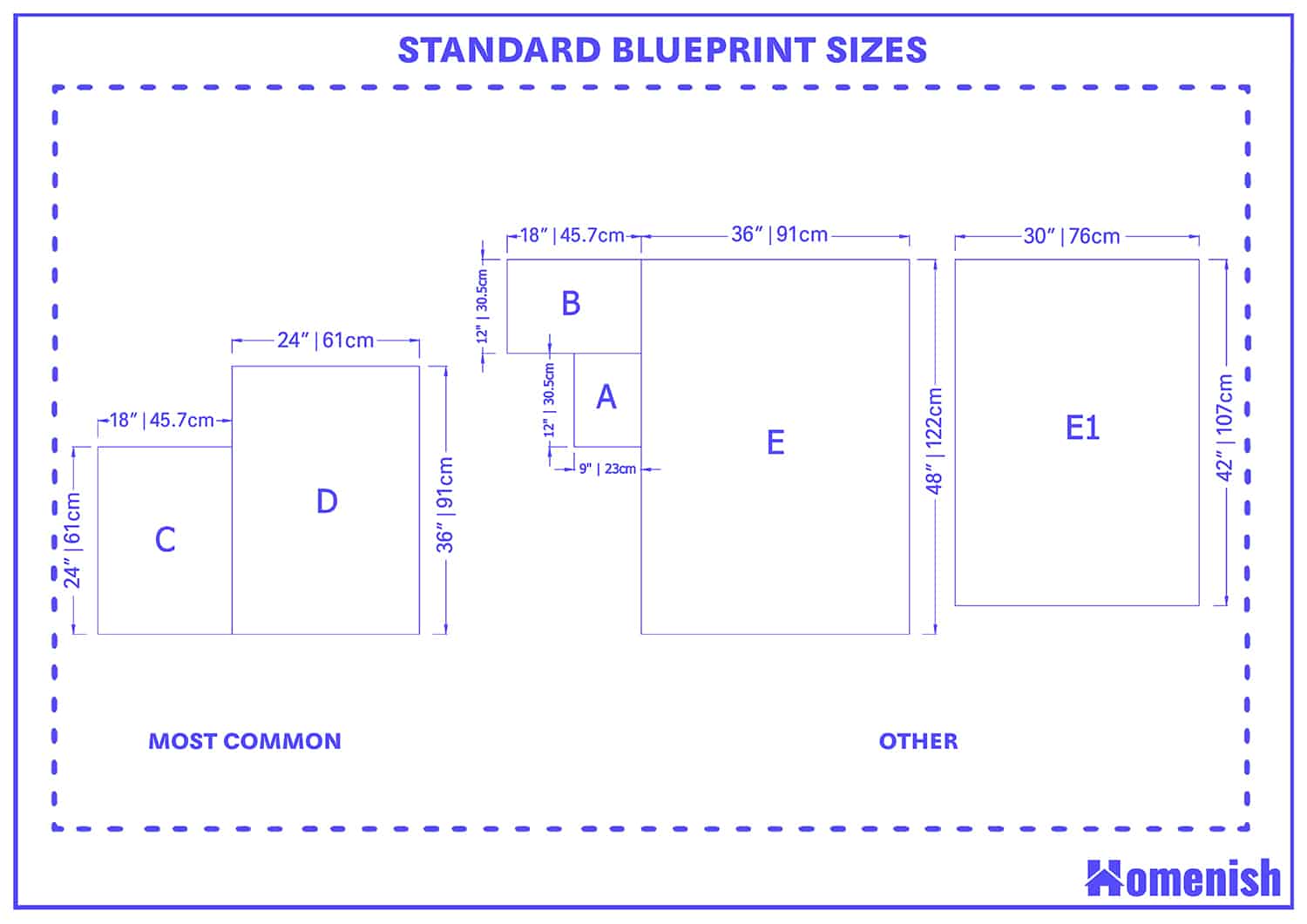If you are having blueprints made, or you’re wanting to create blueprints of your own, then you are going to need to know which size of blueprint will be best for your scenario. Here we look at the standard sizes of blueprints.
The standard size for blueprints made by an architectural firm is ARCH C – 18 inches by 24 inches or ARCH D – 24 inches by 36 inches. Other sizes can be named ARCH A, ARCH B, ARCH E, and ARCH E1.
What is a Blueprint?
A blueprint is a type of technical drawing typically produced by architects and engineers, displaying the plans for how a building is going to look. It is what a construction company would use for reference when constructing the building.
The term ‘blueprint’ is somewhat misleading because these drawings are not actually produced in shades of blue. The word was first used to describe an early type of photocopying invented in 1842 by John Herschel.
The process allowed for large numbers of copies of an original document to be made in a short space of time, and it was adopted across the construction industry to show tradespeople the plans for a building. These were referred to as ‘blueprints’ because the resulting prints were white lines set against a blue background since the process could not reproduce shades of gray or any colors other than blue.
The prints were, in essence, a blue negative of the original drawings. This process is no longer used; however, the term ‘blueprint’ stuck, and the word is now used to refer to any type of plan or drawing of a proposed building or project produced by an architect or engineer.
Standard Blueprint Sizes? How Big It Is?
Blueprints come in various sizes, but there are several standard sizes that are used across the board. This allows for consistency across the industry, but since some buildings are going to be more complex than others, sometimes non-standard blueprints will be necessary.
The most common size for a blueprint produced by an architectural firm is 18 inches by 24 inches or 24 inches by 36 inches. These are known as size ARCH C and size ARCH D. Other sizes include ARCH A, ARCH B, ARCH E, and ARCH E1. The size of a blueprint produced by an engineer will have a different standard size to that produced by an architect.
The standard engineering blueprint sizes are called ANSI A, ANSI B, ANSI C, ANSI D, and ANSI E. The ‘ANSI’ stands for the American National Standards Institute, while ‘ARCH’ is an indicator that the blueprints are architectural.
ARCH A
This is the smallest size of standard blueprint available and will be most suited to small projects or simple builds. It could also be used to hone in on a specific area of a building plan to show a close up, magnified version of a particularly complex part of the structure. The metric size of this blueprint is 228.6 x 304.8 millimeters, and the imperial size is 9 inches by 12 inches.
ARCH B
This is the second size of standard blueprint in ascending order. It is used by architects for technical drawings and will be used by construction specialists as a guide for building a structure. The metric size of this blueprint is 304.8 x 457.2 millimeters, and the imperial size is 12 inches by 18 inches.
ARCH C
This is a mid-sized standard blueprint, and it is one of the most commonly used sizes since it is big enough to be able to clearly show complex drawings, but it’s not so big that the size becomes an inconvenience. If you ever have architectural blueprints produced for you, then the likelihood is that you will receive those in this size or the next size up. The metric measurements for this size of blueprint are 457.2 x 609.6 millimeters, and the imperial size is 18 inches by 24 inches.
ARCH D
This is the other size of architectural blueprints which is most commonly used. Once again, it offers a good balance between being a manageable piece of paper and also allowing the space for plenty of complex drawings to be clearly displayed. The metric size of this blueprint will be 609.6 x 914.4 millimeters, and the imperial size will be 24 inches by 36 inches.
ARCH E
This is the largest size of blueprint used by architects. It is four times bigger than the smallest ARCH A size of blueprint and twice as big as the commonly used ARCH C blueprint. Its size can be difficult to grapple with on-site; however, this size of blueprint is going to be necessary for very large or complex building plans. The metric size of this blueprint is 914.4 x 1219.2 millimeters, while the imperial size is 36 inches by 48 inches.
ARCH E1
This size sits somewhere between the ARCH D and ARCH E sizes, offering a compromise between the two. In metric measurements, its size is 762 × 1067 millimeters, and the imperial size is 30 inches by 42 inches.
ANSI A
This is the smallest size used for standard engineering blueprints. The metric measurements are 215.9 x 279.4 millimeters, and the imperial measurements are 8.5 inches by 11 inches, making it marginally smaller than the smallest blueprint produced by architects.
ANSI B
This is another size used by engineering companies. The metric measurements are 279.4 x 431.8 millimeters, while the imperial measurements are 11 inches by 17 inches.
ANSI C
This is the medium size blueprint used by engineers. The metric measurements are 431.8 x 558.8 millimeters, and the imperial measurements are 17 inches by 22 inches.
ANSI D
This second to largest size blueprint used by engineers measures 558.8 x 863.6 millimeters in the metric system, and 22 inches by 34 inches in the imperial system.
ANSI E
This is the largest size of blueprint used by engineers, measuring 863.6 x 1117.6 millimeters which is the equivalent to 34 inches by 44 inches in the imperial measurement system. Compared with the largest size of architectural blueprint, this size is two inches smaller in width and four inches shorter in length.







